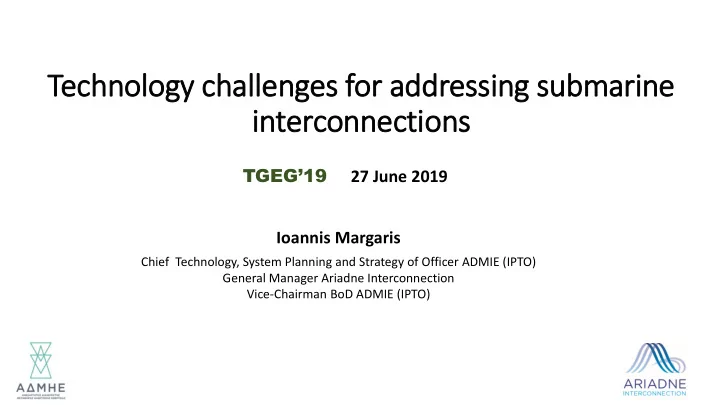

Technology challenges for r addressing s submari rine intercon onnec ection ons TGEG’19 27 June 2019 Ioannis Margaris Chief Technology, System Planning and Strategy of Officer ADMIE (IPTO) General Manager Ariadne Interconnection Vice-Chairman BoD ADMIE (IPTO)
ADMIE Major Projects Major Project Locations ID Project description Expected commissioning year 5 First 400 kV branch to Peloponnese (OHL 2019 1 Megalopoli – Patras – Acheloos) Skiathos island interconnection 2021 2 400 kV 150 kV Crete interconnection (Phase I) 2020 DC 3 Second 400 kV branch to Peloponnese (OHL 2024 4 Megalopoli – Korinthos – Koumoundouros) 2 New 400 kV interconnector to Bulgaria 5 2023 N. Santa (GR) – Maritsa (BG) 1 4 2024 Cycladic Islands interconnection (Phases B’, 6 (2019 for Phase B’, 2020 for C’ and D’) Phace C’ and 2024 for Phase D’) 6 8 7 Crete interconnection (Phase II) 2022 7 3 8 Dodecanese Interconnection 2027 Source: TYNDP 2020 – 2029 (under public consultation)
Islands Interconnection: Main Drivers • Reliable and stable operation of the islands with significant benefits for tourism and general economic activity • Reduced environmental impact on the islands due to the phasing out of autonomous thermal power plants • Reduced energy cost • Reduced charges of services of general interest • Exploitation of the RES potential of the islands • Increasing maturity of Offshore Wind Technology
Islands Interconnection: Challenges (1) Interconnection Lengths – Sea Depths – Terrain Example: Crete Interconnection AC Interconnection: 135km, 980m (longest/deepest AC link in the world) Projects with Similar DC Interconnection: 380km, 1250m Challenges in Europe Hard soils, extreme slopes, shipwrecks, earthquakes etc. SAPEI : Sardinia-Italy, depth 1650 m, 420 km long MONITA : Italy-Montenegro, depth 1200 m, 415 km long SKAGERRAK IV : Denmark-Norway, depth 550 m, 137 km long NORD.LINK : Germany-Norway, depth 230 m, 623 km long NSL : UK-Norway, depth 600 m, 730 km long
Islands Interconnection: Challenges (2) Reliability – Interconnecting Weak Systems Interconnections for ensuring the energy supply of islands Requirement for increased reliability Time constraints for construction, availability, maintenance, fault restoration etc Example: Crete has a peak load of 650 Μ W with 600.000 residents (even more in summer) Interconnection of weak systems (with potential high RES penetration): system stability, voltage control etc New power system structure: AC/DC interconnections, high RES penetration Requirement for advanced system operation and protection schemes Example: Crete weak system will operate with AC and DC links, facing increased RES (wind) penetration
Islands Interconnection: Challenges (3) Surrounding Environment SPACE : Islands (especially in the Aegean sea) face great space limitations. This leads to difficulties in installing substations and other relative infrastructure. NAVAL ACTIVITY : The Aegean sea (and Mediterranean in general) is characterized by intense naval activity that poses risks for submarine cables (trawling, anchors etc.). EXISTING CABLES : A variety of submarine cables/pipes are already installed in the Mediterranean sea (different types of crossings must be studied). ARCHAEOLOGICAL FINDINGS : Both in the submarine and land parts of the interconnections.
Islands Interconnection: Challenges (4) Cable Industry Production Capacities: competing projects-tenders Vessel Availability: deep sea requirements Technology Maturity: need for safe innovation – risk assessment of innovative solutions Market Consolidation Signs: changing market environment
Solutions: Sea depth – length – terrain Cable technologies: XLPE cables for HVAC - MIND and XLPE cables for HVDC interconnections Cable core material : Choice between Cu and Al depending on total costs, losses and weight Cable armoring : New solutions for lighter cables such as Synthetic armoring. First implementation in Evia-Andros-Tinos interconnection project HVAC/HVDC : Moving towards HVDC for long interconnections Voltage level : Moving towards higher voltage levels Cable laying vessels : New vessels able to manage heavier load and suitable for cable laying in large sea depths
Solutions: Reliability-Operation STATCOM/SVC: Reactive power compensation for voltage control in the interconnected islands (e.g. installed SVC in Syros – Cyclades Phase I) Advanced Control Center: New Control Center in Crete communicating with the National Control Center in Athens. Protection schemes for hybrid AC/DC systems: State-of-the-art protection schemes in Crete Multi-terminal HVDC: Provisions for connections with other HVDC systems in the region (HVDC grid) Enhanced communications: Dedicated Fiber Optic cables are laid with the power cables used both for power system operation and for providing communication services
Solutions: Surrounding Environment Challenges Marine surveys Civil/Mechanical/Naval engineering Burial assessment/Cable protection Community/local authorities engagement High Voltage GIS Cable/pipe crossing studies
Recommend
More recommend